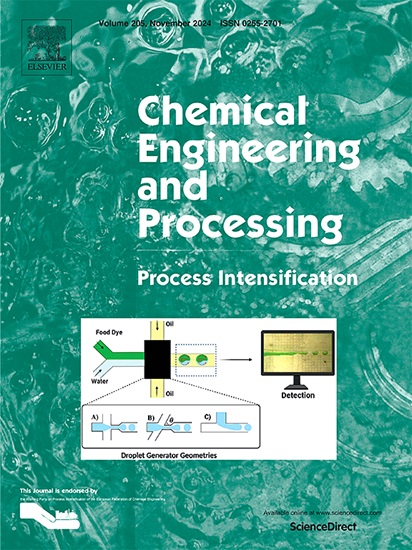Numerical and experimental investigation of O/W dispersed flow characteristics in a dual-stage toothed continuous rotor-stator mixer
IF 3.8
3区 工程技术
Q3 ENERGY & FUELS
Chemical Engineering and Processing - Process Intensification
Pub Date : 2025-07-05
DOI:10.1016/j.cep.2025.110427
引用次数: 0
Abstract
The effects of structural and operational parameters on the emulsification performance of a two-stage toothed continuous rotor-stator mixer (RSM) in water-in-oil emulsification are systematically investigated in this study. Experimental evaluation was conducted to assess emulsification efficiency, while flow field visualization revealed key features of the two-phase flow, offering insights into the droplet breakup mechanism within the mixing chamber. Results indicate that outer stator parameters—slotted area, slot angle, and slot width—significantly affect emulsification by altering flow distribution. Among operational factors, rotor speed and mixing time play dominant roles. Notably, high power input increases the probability of droplet breakup but does not guarantee smaller droplet sizes. In two-stage RSMs, a wider stator slot, due to its weaker pumping capacity and longer fluid residence time, enhances emulsification over short durations. A correlation between the Weber number and Sauter mean diameter was developed, providing a basis for optimizing RSM design and operation in emulsification applications.

双级齿状连续转子-定子混合器O/W分散流动特性的数值与实验研究
系统地研究了两级齿状连续转子-定子混合器在油包水乳化过程中结构参数和操作参数对其乳化性能的影响。实验评估了乳化效率,流场可视化显示了两相流的关键特征,为研究混合室内液滴破碎机理提供了新的思路。结果表明,外定子参数槽面积、槽角和槽宽通过改变流动分布对乳化有显著影响。在运行因素中,转速和混合时间起主导作用。值得注意的是,高功率输入增加了液滴破裂的可能性,但不能保证液滴尺寸更小。在两级rsm中,由于较弱的泵送能力和较长的流体停留时间,较宽的定子槽可以在短时间内增强乳化效果。建立了Weber数与Sauter平均直径之间的相关性,为优化RSM的设计和乳化应用中的操作提供了依据。
本文章由计算机程序翻译,如有差异,请以英文原文为准。
求助全文
约1分钟内获得全文
求助全文
来源期刊
CiteScore
7.80
自引率
9.30%
发文量
408
审稿时长
49 days
期刊介绍:
Chemical Engineering and Processing: Process Intensification is intended for practicing researchers in industry and academia, working in the field of Process Engineering and related to the subject of Process Intensification.Articles published in the Journal demonstrate how novel discoveries, developments and theories in the field of Process Engineering and in particular Process Intensification may be used for analysis and design of innovative equipment and processing methods with substantially improved sustainability, efficiency and environmental performance.

 求助内容:
求助内容: 应助结果提醒方式:
应助结果提醒方式:


